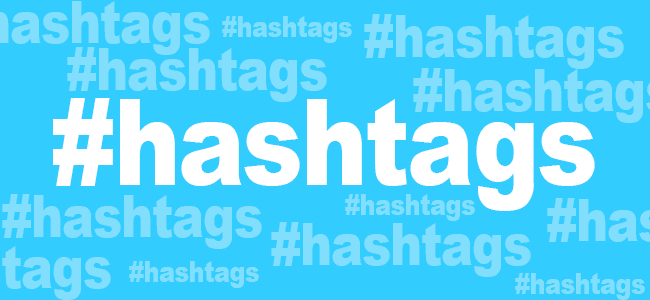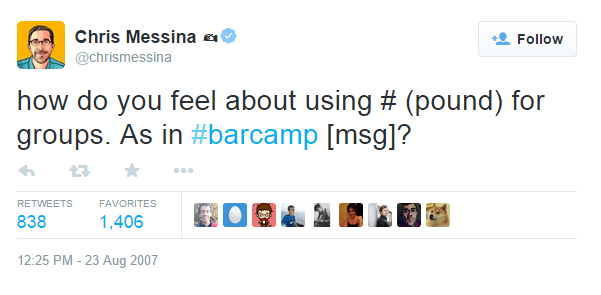I went out with a group of friends the other night, and one of them seemed confused by my shirt (#sexy). I looked at her puzzled and thought she was attempting to be cute.
“What do you mean ‘what is it?’ It’s a hashtag.” I replied, with somewhat of an confused look in return. Has she been #LivingUnderARock?
If you are like my friend and haven’t a clue what hashtags (#) are, or worse yet think the little symbols are only used for weights and numbers you might want to read further.
Hashtag History Lesson
The common consensus is that hashtags were a user innovation that was later adopted by Twitter as an actual feature. The first use of a hashtag came from Chris Messina on August 23, 2007.
(source: Twitter)
It then later was adopted in an October 23, 2007 tweet from Nate Ritter used to report the San Diego fire in which he included the hashtag #sandiegofire.
But it wasn’t until July 2009 that Twitter officially made hashtags a permanent feature by hyperlinking them to search results. Soon other social networks jumped on the tagging bandwagon.
- Tumbler – August 18, 2009
- Instagram – January 27, 2011
- Flickr – March 17, 2013
- Facebook – June 12, 2013
Hashtags have even made their way into our vocabulary. “Hashtag” was added to the Oxford English Dictionary last June.
Hashtags in the Marketing World
From 2007 to present, hashtags have quickly been considered the new URL of the web. They are becoming known for their powerful marketing and communications literary prowess.
“In 1995, using an actual URL in advertisements was commonplace. In 2010 that evolved into Twitter and Facebook brand pages. Today, hashtags are the new URL,” – Chirpify Founder, Chris Teso, 2013
When used to the fullest of their ability (and of course correctly), hashtags have the wings to increase content reach, build community, support both marketing and branding efforts, as well as promote all kinds of events.
Hashtags of course improve searchability. On social media networks, where there are pages upon pages of information to sift through, users often search for certain hashtags that correspond with their desired information topic. By using a hashtag yourself, you can tap into a popular or even viral conversation that aligns with your brand.
How to Use Hashtags
Using a hashtag in a social media post is as simple as adding the # in before a single word or phrase without spaces.
-
Don’t go overboard and string too many words together.
-
Don’t spam with hashtags. Don’t over-tag a single tweet or post. See The Ultimate Hashtag Cheat Sheet for more information on what is the right number of #’s for each social network.
-
Use hashtags on posts relevant to the topic.
Tips to Get Your Hashtag Working
Start the conversation – Create a hashtag that is associated with a product, campaign, or event. This will give users a way to keep a conversation going with your brand. For instance Jeju West used a conversation starter tactic by asking customers to post photos of themselves wearing the company’s beauty sheet masks. “People look like they are in a Halloween crossover between Jason (Friday the 13th) and The Silence of the Lambs when they wear the mask,” says Jessica Shin, president of Jeju West.
“We set up a gallery where people can submit pictures of themselves in beauty sheet masks using hashtag #JWmasqueball. We use Woobox to power the gallery; since pictures can be submitted automatically via Instagram or Twitter using the named hashtag,” Shin says. When #JWmasqueball shows up in users’ news feeds, some click out of interest and learn about Jeju West in the process.
Use Trending Hashtags – This is a good way to accumulate new followers. The key here though is to find the most popular and frequently used/searched for hashtags that align with your brand.
There are a few tools that you can use to find trending hashtags such as:
- Twubs.com: Lets you register and discover hashtags.
- Hashtags.org: Searches for hashtags and discovers currently trending hashtags.
- TrendsMap.com: Shows you trending hashtags based on location.
- TagDef.com: Provides an explanation of what popular hashtags mean, such as #tbt, which stands for Throwback Thursday.
Hashtags can be a powerful tool to build your audience and thus your business. Follow the steps and knowledge above to get you started.





Jimmy and Timber are just to Funny #theyonfire